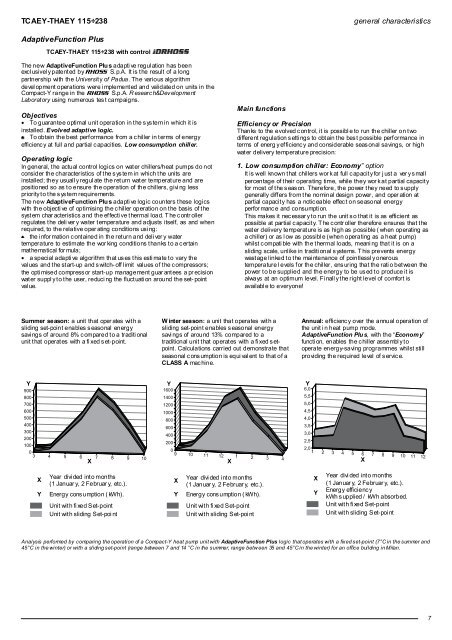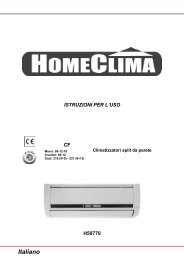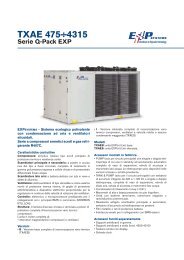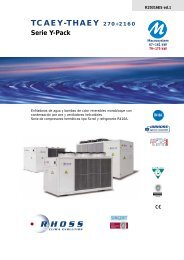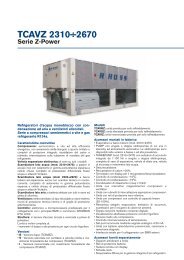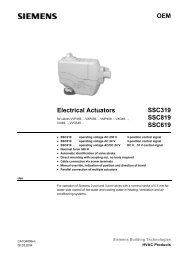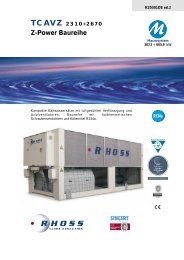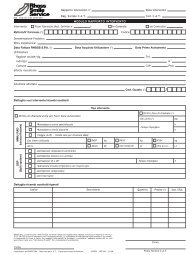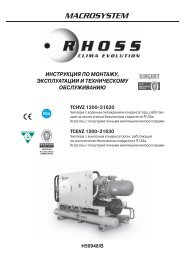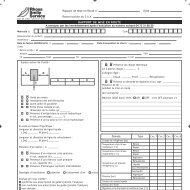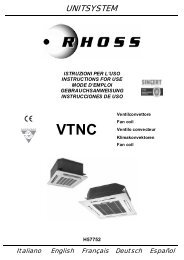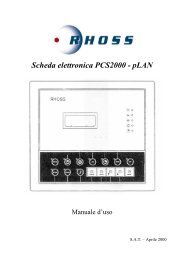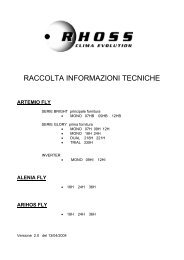TCAEY-THAEY 115÷238 - Rhoss
TCAEY-THAEY 115÷238 - Rhoss
TCAEY-THAEY 115÷238 - Rhoss
You also want an ePaper? Increase the reach of your titles
YUMPU automatically turns print PDFs into web optimized ePapers that Google loves.
<strong>TCAEY</strong>-<strong>THAEY</strong> 115÷238<br />
general characteristics<br />
AdaptiveFunction Plus<br />
<strong>TCAEY</strong>-<strong>THAEY</strong> 115÷238 with control<br />
The new AdaptiveFunction Plus adaptive regulation has been<br />
excl usivel y patent ed by RHOSS S.p.A. It is the result of a long<br />
partnership with the University of Padua. The various algorithm<br />
devel opment operations were i mplement ed and validated on units in the<br />
Compact-Y range in the RHOSS S.p.A. R esearc h&Dev elopment<br />
Laborat ory using numerous tes t campaigns.<br />
Objectives<br />
• To guarantee optimal unit operation in the system in which it is<br />
installed. Evolved adaptive logic.<br />
• To obtain the best performance from a chiller in terms of energy<br />
efficienc y at full and partial c apacities. Low consumption chiller.<br />
Operating logic<br />
In general, the actual control logics on water chillers/heat pumps do not<br />
consider the characteristics of t he s ys tem in which t he units are<br />
installed; they usuall y regul ate the ret urn wat er temperat ure and are<br />
positioned so as to ensure the operation of the chillers, giving less<br />
priority to the s ys tem requirements.<br />
The new AdaptiveFunction Plus adaptive logic counters these logics<br />
with the objective of optimising the chiller operation on the basis of the<br />
syst em char acteristics and the ef fecti ve t hermal load. T he c ontr oller<br />
regulates t he deli ver y water t emperature and adjusts itself, as and when<br />
required, to the relative oper ating conditions usi ng:<br />
• the i nfor mation c ont ained in the ret urn and deli ver y water<br />
temperature to estimate the wor king conditions t hanks t o a c ertain<br />
mathematical formula;<br />
• a special adapti ve algorithm that us es this esti mate to vary the<br />
val ues and t he st art-up and s witch- off limit values of t he c ompressors;<br />
the opti mised compress or start-up management guar ant ees a pr ecision<br />
wat er suppl y t o t he user, reduci ng the fluct uati on around the set- point<br />
val ue.<br />
Main functions<br />
Efficiency or Precision<br />
Thanks to the evolved control, it is possible to run the chiller on two<br />
different regulation s etti ngs to obt ain t he bes t possible performance in<br />
terms of energ y ef ficienc y and considerable seas onal savings, or high<br />
wat er delivery temperat ure precision:<br />
1. Low consumption chiller: Economy” option<br />
It is well known that chillers wor k at full capacity for just a ver y small<br />
percentage of t heir operating time, while they wor k at partial capacit y<br />
for most of t he s eas on. Therefore, the power t hey need to s upply<br />
generally diff ers from t he nominal design power, and oper ation at<br />
partial capacit y has a notic eable effec t on seasonal energy<br />
perfor manc e and consumpti on.<br />
This makes it nec essar y t o run the unit s o t hat it is as efficient as<br />
possible at partial c apacit y. T he c ontr oller therefore ensures that t he<br />
wat er delivery temperat ure is as high as possible ( when operating as<br />
a chiller) or as low as possible (when operating as a heat pump)<br />
whilst c ompati ble with the t hermal loads, meani ng that it is on a<br />
sliding scale, unlike in traditi onal s ystems. T his prevents energy<br />
wast age linked t o t he mai ntenance of pointlessl y onerous<br />
temperature levels for the chiller, ensuring that the ratio between the<br />
power t o be supplied and the energy to be us ed t o produce it is<br />
always at an optimum level. Fi nall y t he right level of comfort is<br />
availabl e to everyone!<br />
Summer season: a unit that oper ates wit h a<br />
sliding set-point enables s easonal energy<br />
savi ngs of around 8% c ompared t o a traditi onal<br />
unit t hat operat es with a fi xed s et-point.<br />
W inter season: a unit that operates wit h a<br />
sliding set-point enables s easonal energy<br />
savi ngs of around 13% compared to a<br />
traditional unit t hat operat es with a fi xed s etpoint<br />
. Calculations carried out demonstrate that<br />
seasonal c ons umption is equi val ent to that of a<br />
CLASS A mac hine.<br />
Annual: efficienc y over the annual operation of<br />
the unit i n heat pump mode.<br />
AdaptiveFunction Plu s, with the “Economy”<br />
function, enables the chiller assembly to<br />
operate energy-saving programmes whilst still<br />
providing the required level of service.<br />
Y<br />
900<br />
800<br />
700<br />
600<br />
500<br />
400<br />
300<br />
200<br />
100<br />
0<br />
3 4 5 6<br />
X<br />
7 8 9 10<br />
Y<br />
1600<br />
1400<br />
1200<br />
1000<br />
800<br />
600<br />
400<br />
200<br />
0<br />
9 10 11 12 1 2 3<br />
X<br />
4<br />
Y<br />
6,0<br />
5,5<br />
5,0<br />
4,5<br />
4,0<br />
3,5<br />
3,0<br />
2,5<br />
2,0 1 2 3 4 5 6 7 8 9 10 11 12<br />
X<br />
X<br />
Y<br />
Year divi ded int o months<br />
(1 Januar y, 2 Februar y, etc.).<br />
Energy cons umption ( kWh).<br />
Unit with fi xed Set-point<br />
Unit with sliding Set-point<br />
X<br />
Y<br />
Year divi ded int o months<br />
(1 Januar y, 2 Februar y, etc.).<br />
Energy cons umption ( kWh).<br />
Unit with fi xed Set-point<br />
Unit with sliding Set-point<br />
X<br />
Y<br />
Year divi ded int o months<br />
(1 Januar y, 2 Februar y, etc.).<br />
Energy efficienc y<br />
kWh s upplied / kWh absorbed.<br />
Unit with fi xed Set-point<br />
Unit with sliding Set-point<br />
Analysis performed by comparing the operation of a Compact-Y heat pump unit with AdaptiveFunction Plus logic that operates with a fixed set-point (7°C in the summer and<br />
45°C in the winter) or with a sliding set-point (range between 7 and 14 °C in the summer, range between 35 and 45°C in the winter) for an office building in Milan.<br />
7


